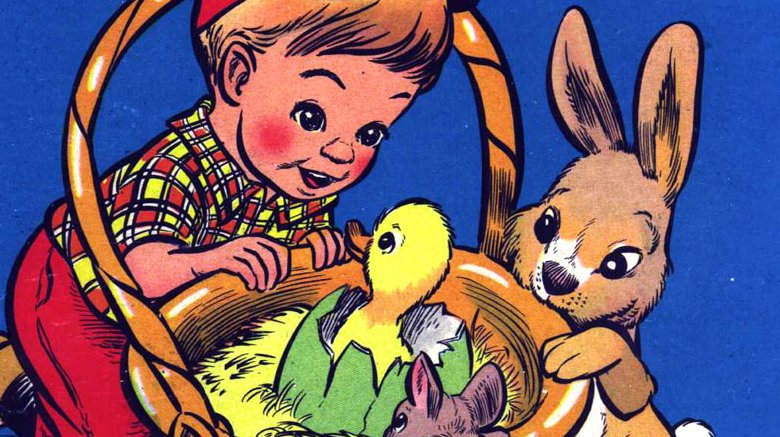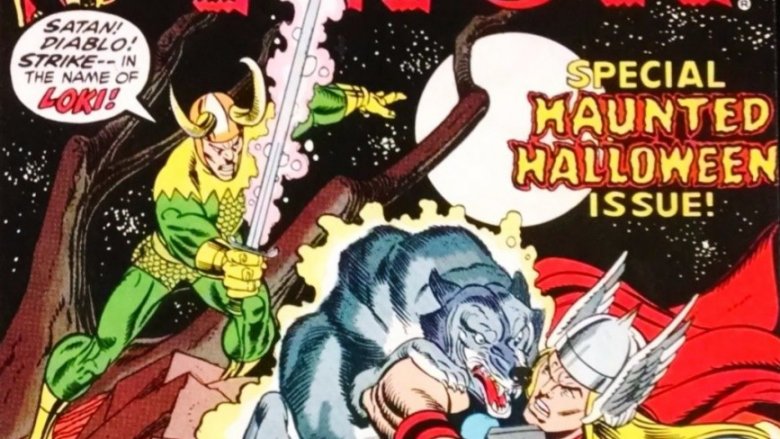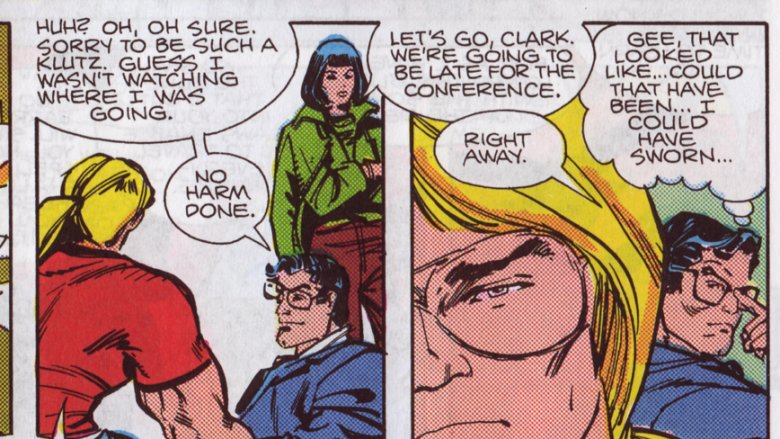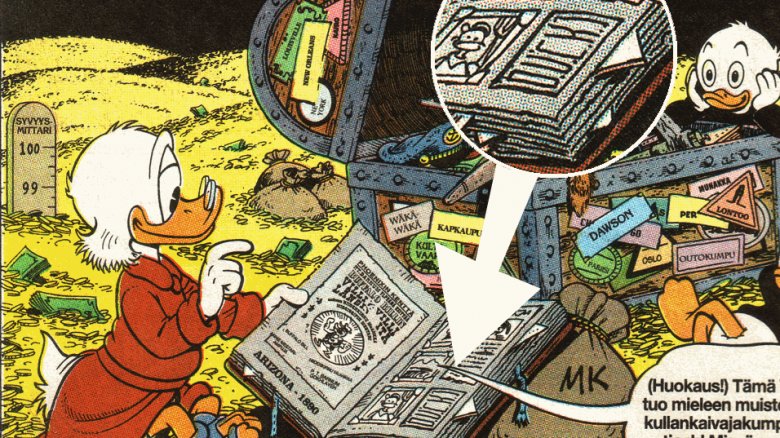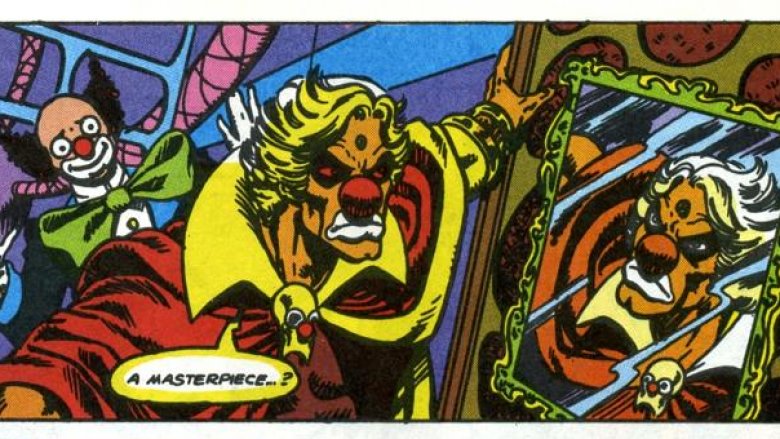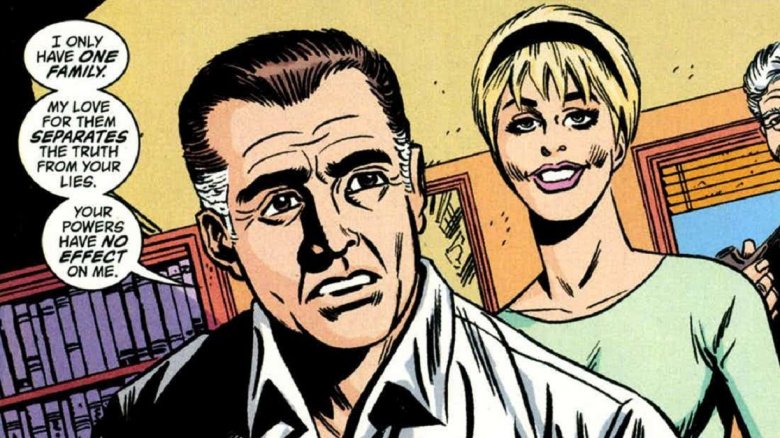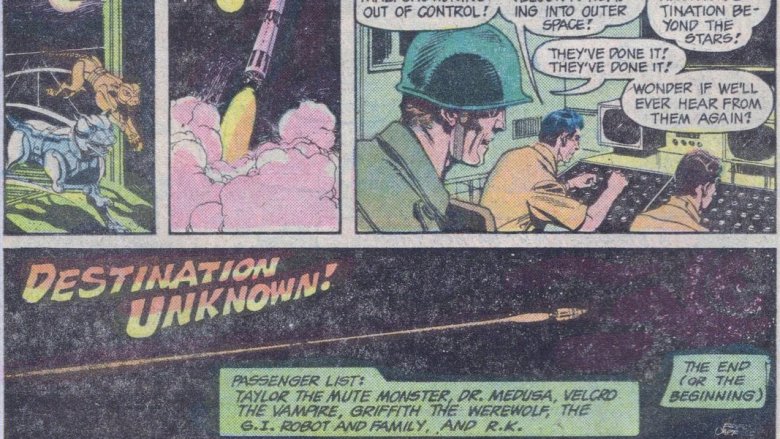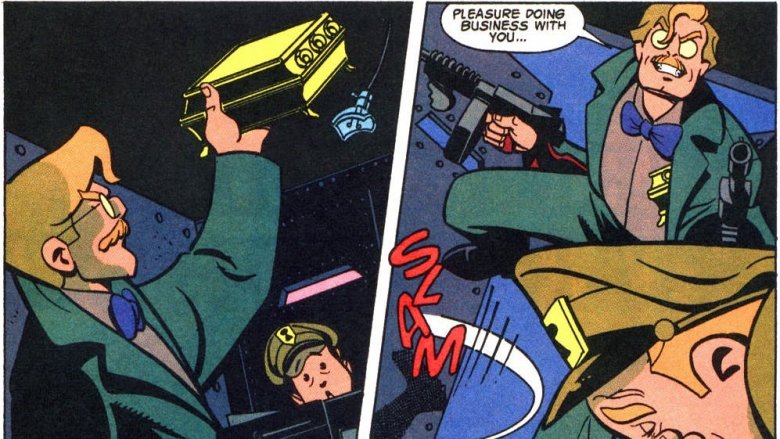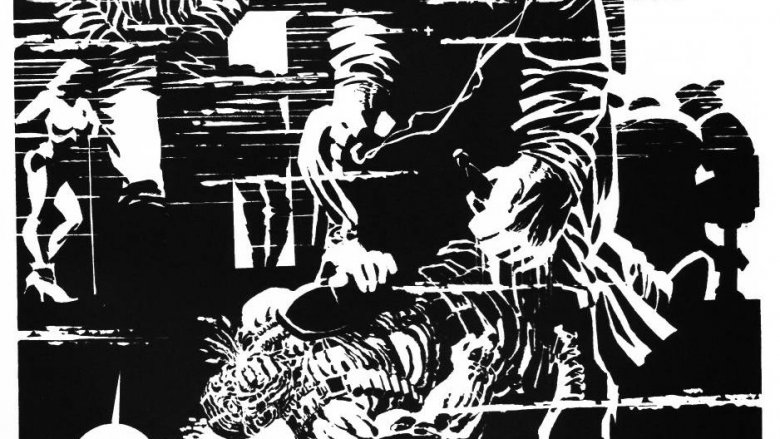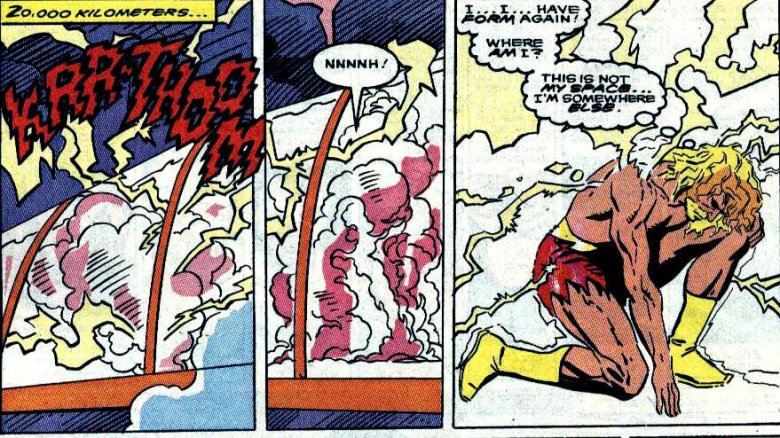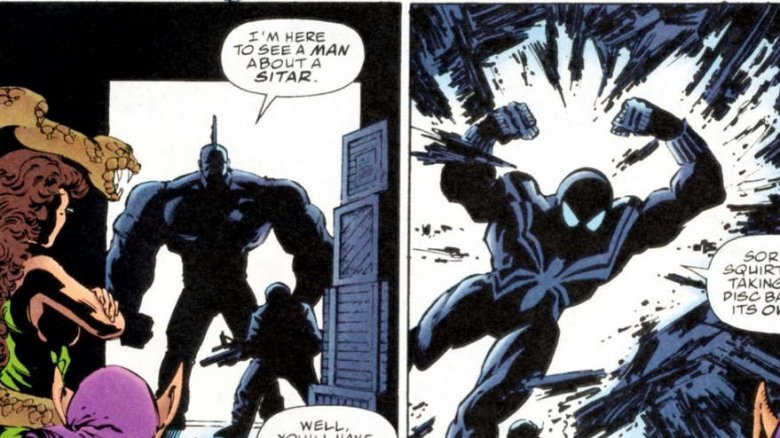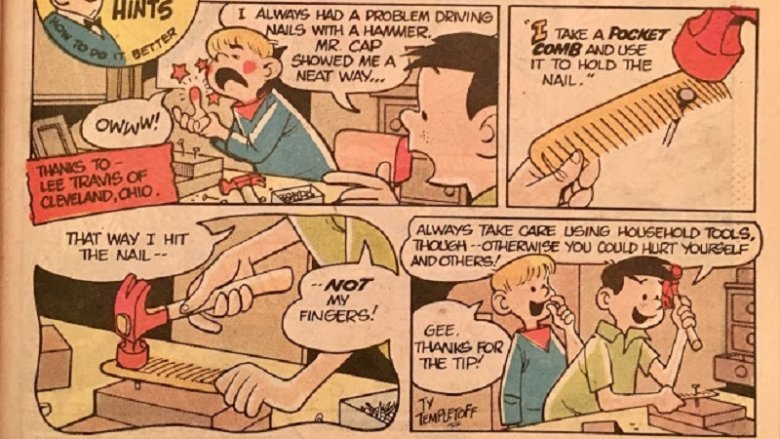Most Bizarre Easter Eggs In Comics
We may receive a commission on purchases made from links.
Any sufficiently engaged fan loves finding Easter eggs in their media. You know, those little hidden details and in-jokes sprinkled through the background of movies, video games, or comic books that reward close inspection or a wider knowledge of pop culture?
Comic books — a visual medium in which the artist has tons of panels to fill up and occasionally a strange sense of humor — are replete with Easter eggs. But while there are certain comics renowned for their background gags and references, like Kingdom Come or Top 10 or League of Extraordinary Gentlemen, there's not much you can say about most of those other than "Hey, look, that guy in the corner is Popeye."
We're digging a little deeper into the more convoluted, obsessive, and strange details that require secret knowledge to understand. These will include secret crossovers, not-so-secret beefs between creators and publishers, sincere tributes to beloved friends, and possibly the darkest joke you'll ever see in a superhero comic.
Grab your baskets! Let's go hunting.
The secret first JLA/Avengers crossover
The first official crossover between comics' two biggest publishers, Marvel and DC, was 1976's Superman vs. the Amazing Spider-Man. Before this, however, there were a surprising number of secret crossovers done by writers and artists, partly for funsies, partly to wink at their readers, and, presumably, partly to see if they could sneak one past their bosses. One notable example of this is a story written by Steve Skeates in 1971's Aquaman #56 (the final issue of that series) that was continued three years later when Skeates was writing for Marvel in The Savage Sub-Mariner #72.
But the first-ever Marvel/DC crossover, unofficial though it was, had its origins in a Halloween parade in Rutland, Vermont. Thanks to Rutland local Tom Fagan, the Rutland parade gained many fans in the comics creator community due to its inclusion of superhero-themed costumes and floats. Soon the parade and Fagan himself were appearing in comics, like 1970's Avengers #83 and 1971's Batman #237.
But it was in 1972 that writers at both Marvel and DC decided to try something new. By cleverly utilizing the real-life Rutland parade as well as including the real-life creators of the books as characters, they were able to weave a story through the pages of Marvel's Amazing Adventures #16 and The Mighty Thor #207 with DC's Justice League of America #103 sandwiched in between. The story hinges on Felix Faust stealing writer Steve Englehart's car. It's pretty bananas. You can read the full history of the story and parade at ComicsAlliance.
Thor bumps into Superman, literally
Speaking of unofficial crossovers, we could probably find dozens of times Marvel comics have featured reporters who look suspiciously like Clark Kent and Lois Lane, or that DC comics have featured news photographers who bear a striking resemblance to one friendly neighborhood Peter Parker.
But the best such instance likely occurred in 1984's Thor #341, during writer-artist Walt Simonson's character-defining run on the god of thunder. By this time, Thor had dropped his traditional body-swap secret identity of Doctor Donald Blake and so could no longer change forms to look like a normal human by banging his hammer on the ground. But, so that he could more easily blend into the human populace, SHIELD director Nick Fury helpfully set him up with the false identity of Sigurd Jarlson, a construction worker who doesn't look anything at all like Thor, because he wears glasses and his hair is pulled back. Thor doesn't wear glasses, duh.
To really drive home the joke, Simonson has "Jarlson" bump into a bespectacled reporter on his way to a press conference. Thor knocks down the other guy, who apologizes for being clumsy, before his dark-haired female colleague says, "Let's go, Clark." As he walks away, the reporter pushes up his glasses and says, "Gee, that looked like ... naaah." Could the fact that Thor knocked Clark Kent to the ground be Simonson's way of saying who would win in a fight? Naaah, probably just a gag. Right?
D.U.C.K. Hunt
If you love the classic 1987 cartoon DuckTales or its excellent 2017 reboot, you largely have one man to thank: Carl Barks, Disney's number one Duck Man. In a time when creators of Disney comics weren't allowed to sign their own names to their work, Barks became known among fans as "the Good Duck Artist" due to his ability to move deftly from hilarious short gag stories to expansive, globe-spanning adventures. Barks created such enduring characters and concepts as Magica DeSpell, the Beagle Boys, Gyro Gearloose, the number one dime, and, oh yeah, Uncle Scrooge himself in stories ranging from the 1940s to the 1970s.
There have been many Barks imitators in the U.S. and Europe (where Donald Duck comics are incredibly popular) since then, but Uncle Carl's greatest successor would come in the form of American cartoonist Don Rosa, who began producing Duck stories in the mid-1980s, including the critically acclaimed 12-part Life and Times of Scrooge McDuck.
Rosa openly and proudly acknowledges the debt he owes to Carl Barks, a fact he makes clear by including a special dedication hidden in the covers and first panels of (almost) all his Duck stories: D.U.C.K., which stands for "Dedicated to Unca Carl from Keno." (Keno is Don Rosa's real first name.) This one is like a true Easter egg in that you have to really search for it and it's often hidden in the grass.
Stan Lee is a clown
Not all Easter eggs are loving tributes or fun treats for eagle-eyed fans, however. Let's take a dip into the deep end of snarky Easter eggs for a minute.
The first thing you need to know is that when it comes to cosmic superhero comics, Jim Starlin's output is basically unparalleled in influence. In the course of his work on such titles as Captain Marvel and Warlock (and a notable issue of Iron Man), he introduced Thanos, Gamora, Drax the Destroyer, and others. The point is, if you like the Guardians of the Galaxy movies, maybe drop him a thank-you note.
The second thing is that things were changing at Marvel in the mid-1970s. Stan Lee had taken on the role of publisher with Roy Thomas taking over as editor-in-chief, and artist John Romita assumed the role of art director. Then there was a bit of a revolving door situation in the editor-in-chief chair, with several people filling the role in the span of two years.
Starlin decided to spoof this situation in Strange Tales #181, in which Adam Warlock is injected into a sort of virtual reality world run by alien clowns who want to make everyone conform to their clown standards. The main clowns are named Lens Tean and Jan Hatroomi, which for you non-Jumble fans out there are anagrams of Stan Lee and John Romita. The whole thing is a pretty biting satire, and you can read a detailed breakdown of the issue at Comic Book Resources.
How to get fired via Easter egg
Despite Starlin's critique of the big bosses at Marvel, he would continue to make Adam Warlock comics for quite a while. One artist wasn't so lucky when he decided to critique the suits in the background of one of his comics.
In 2001, Marvel produced one-shot specials as tie-ins to the mini-series Universe X, which was a sequel to the earlier Earth X, itself more or less a Marvel take on DC's earlier (and more successful) mini-series Kingdom Come. One of these tie-ins was Universe X: Spidey, written by Jim Krueger and Alex Ross and featuring pencil art by Jackson Guice. Some scenes are set in a illusory world in which Gwen Stacy never died. To complete the illusion of these events happening in a different world, these scenes were inked by classic Spider-Man artists Jan Hatroomi — er, John Romita — and Al Milgrom.
One of these scenes takes place in a room full of bookshelves, and some of the books have titles on the covers. Mostly these are things like Marvels (another Alex Ross project) and The Sound and the Fury (this one is not a comic book). But the one that got Al Milgrom fired from his staff artist position at Marvel was the row of books that read "Harras/ha, ha/he's/gone/good ridd/ance to/bad rubbish/he was a/nasty S.O.B," referring to Bob Harras, the then-recently fired editor-in-chief of Marvel Comics. The book got recalled and reprinted with the message erased.
Writer shoots himself into space
Robert Kanigher was one of the most prolific writers and editors of the Golden and Silver Ages of comics. In a career that spanned five decades, he wrote both the Jay Garrick and Barry Allen versions of the Flash, created Black Canary, and wrote more issues of Wonder Woman than anyone else in history. He is perhaps best known, however, for his large amount of work in the genre of war comics, for which he created Sgt. Rock, Enemy Ace, the Losers, and the Unknown Soldier, among others.
He also wasn't afraid to write himself into his own comics before Grant Morrison made it cool. Notably in 1965's Wonder Woman #158, Kanigher calls the cast of the book into his office to let them know that, under pressure from the demands of the then-emergent fan culture, he would be returning the book to its 1940s roots, and that the entire current cast was fired. This is only the second weirdest story in an issue that also features Wonder Woman fighting a giant racist egg.
Kanigher wrote himself in again, albeit more secretly, in 1983's Weird War Tales #124, the final issue of that series. Apparently editorial gave Kanigher one page to wrap up his storylines for Creature Commandos and GI Robot, so he has them shot off into space by a general who shared a name with the book's editor – with one extra passenger: Robert Kanigher. Presumably he was flipping DC the bird all the way up.
No more Mr. Nice
Wow, lots of middle fingers to editors here. Let's see if we can find an example of a secret reference to how good an editor is instead.
In 1993, Kelley Puckett and Mike Parobeck introduced a trio of new villains in the pages of Batman Adventures #10 who would go on to be known as the Threatening Three. Batman Adventures was the title meant to tell stories in the style of Batman: The Animated Series, but the Threatening Three were completely original characters known as Mastermind, the Perfesser, and Mr. Nice. Long story short, these characters were based on three real-world DC editors: the obsessively detailed Mastermind was then-executive editor Mike Carlin; the loquacious Perfessor was Batman group editor Denny O'Neil; and Mr. Nice was writer/editor Archie Goodwin, whom writer Chris Sims described as being "regarded as one of the most genuinely kind people that the industry has ever seen."
Mr. Nice, true to his name, is not a very effective criminal due to being constantly distracted by his own nice instincts. Nevertheless, he is well respected by his peers, just like the man who inspired him. Archie Goodwin died of cancer in 1998, and the next year Batman: Gotham Adventures #13 featured the last Threatening Three story, titled only "The End." While the story of the Three dealing with their friend Mr. Nice leaving Gotham holds up on its own, it's much more powerful when you know it was actually DC saying goodbye to a beloved friend.
A strange visitor in Sin City
Frank Miller is one of the most influential comics creators of all time, with his historic run on Daredevil and Batman stories like Dark Knight Returns indelibly changing the landscape of superhero comics forever. Additionally, the neo-noir storytelling and stark black and white linework on his creator-owned series Sin City helped make him as much a household name as any comics creator can be thanks to the 2005 film adaptation.
Jim Lee (no relation to Stan) helped make a generation of kids into X-Men fans, with his 1991 X-Men #1 becoming the best-selling single issue of all time and his aesthetic and designs being at the heart of the 1992 X-Men animated series. When he left Marvel comics to help found Image in 1992, legions of fans followed him to his new series WildC.A.T.s (which received its own, less successful cartoon).
However, also in 1992, Lee debuted a new character named Deathblow in the pages of Darker Image. For this story, Lee used a then-new style, with chunkier ink lines that we'll charitably call "reminiscent" of Miller's linework. Miller definitely noticed the superstar biting his style and commented on it in a panel in 1993's A Dame to Kill For by having his character Marv stomp on a fellow who looks somewhat out of place in Basin City.
There must have been no hard feelings, though, as in 2005 Miller and Lee teamed up for the notorious series All Star Batman and Robin, perhaps better known as that "I'm the goddamn Batman" comic.
Buried Alien
What's that you say? More secret crossovers? Well, okay, if you insist.
This one happened during the period when Marvel and DC were actually doing official crossovers and includes more or less an entire issue, so it's more of an Easter basket than an Easter egg, but it still requires having more information than just what's on the page to fully appreciate.
In 1986, the second man known as the Flash, Barry Allen, died saving the multiverse during Crisis on Infinite Earths, running so fast that he more or less dissolved into the Speed Force. For about the next 20 years after that, the Flash was Barry's nephew and former sidekick, Wally West, who held the title until Barry unexpectedly emerged from the Speed Force again in 2009's Final Crisis, only to take back over as the Flash, accidentally ruin reality, ruin it in a different way, and then get rewarded with his own TV show.
But he may have emerged from the Speed Force even earlier and even more unexpectedly than that. In Marvel's Quasar #17 from 1990, one of the Elders of the Universe arranges a race for all the fastest folks in the Marvel universe, including Quasar, Makkari of the Eternals, Quicksilver, the Whizzer (yes, this is a real character), and more. Suddenly a guy in red and yellow rags appears in — ahem — a flash and smokes them all. When the stranger is asked what his name is, he can't remember, saying it's something like "Buried Alien."
Howard the Duck rescue mission
This secret crossover is the weirdest of them all, but it's also the one that had the most personal significance for one of its creators.
Dedicated comics fans know that, despite the reputation of its infamous movie adaptation, Howard the Duck was one of the best comics of the 1970s, thanks largely in part to writer Steve Gerber's sharp and incisive writing. However, Gerber had an incredibly contentious relationship with Marvel, due primarily to its handling of the character of Howard.
In fact, in 1982, Gerber created the character Destroyer Duck together with Jack Kirby (who also had his own disputes with Marvel) in order to raise money for lawsuits against Marvel regarding ownership of Howard. By 1995, Gerber was working with Marvel again but had decided enough was enough and produced a secret two-part crossover: one part was in Spider-Man Team-Up #5 and the second was in Savage Dragon/Destroyer Duck.
In the first story, Spider-Man and Howard meet two shadowy figures in a warehouse. But in the second, the readers learn that these figures were, in fact, Savage Dragon and Destroyer Duck. In that issue, Howard is cloned, the real Howard dyes his feathers green and renames himself Leonard, and the clone is the one that leaves the warehouse with Spider-Man. So, according to Gerber at least, any subsequent appearance of Howard was just a soulless shell, an empty copy of the real thing. Does this secret fact actually solve anything for Gerber? Nah, but it probably made him feel better.
The dark secret of Cap's Hobby Hints
All right, so this one goes down a bit of a rabbit hole, and like a rabbit hole, it's going to get a little dark. Hang in there; this one is wild.
In the 1960s, many DC comics featured a little bonus strip called Cap's Hobby Hints, which were basically tips for different arts and crafts written and drawn by Henry Boltinoff, brother of editor Murray Boltinoff. The 1988 special Christmas With the Super-Heroes #1 featured the first new Cap's Hobby Hints in years, with the signature "Ty Templetoff" suggesting it was drawn by cartoonist Ty Templeton in homage to Boltinoff.
But, if you read the strip, you may ask yourself, "Where's the spoof? What's the joke?" There doesn't appear to be one. It just looks like a regular hobby hint about hammer safety. Well, hold on to your hats. The clue is in the box that thanks one "Lee Travis" for the suggestion. Lee Travis is the secret identity of the Golden Age character the Crimson Avenger, who in 1988 had gained renewed attention thanks to a well-received mini-series by writers Roy and Dann Thomas and artist Greg Brooks.
Despite critical acclaim, however, Greg Brooks didn't have much of a career after Crimson Avenger. He was in prison by Christmas 1988 for murdering his wife. With a hammer. (And according to writer Bob Rozakis, the Brooks murder story takes even weirder turns than that, with stolen identities and secret babies and all.) Dark stuff, Templetoff, whoever you are.
